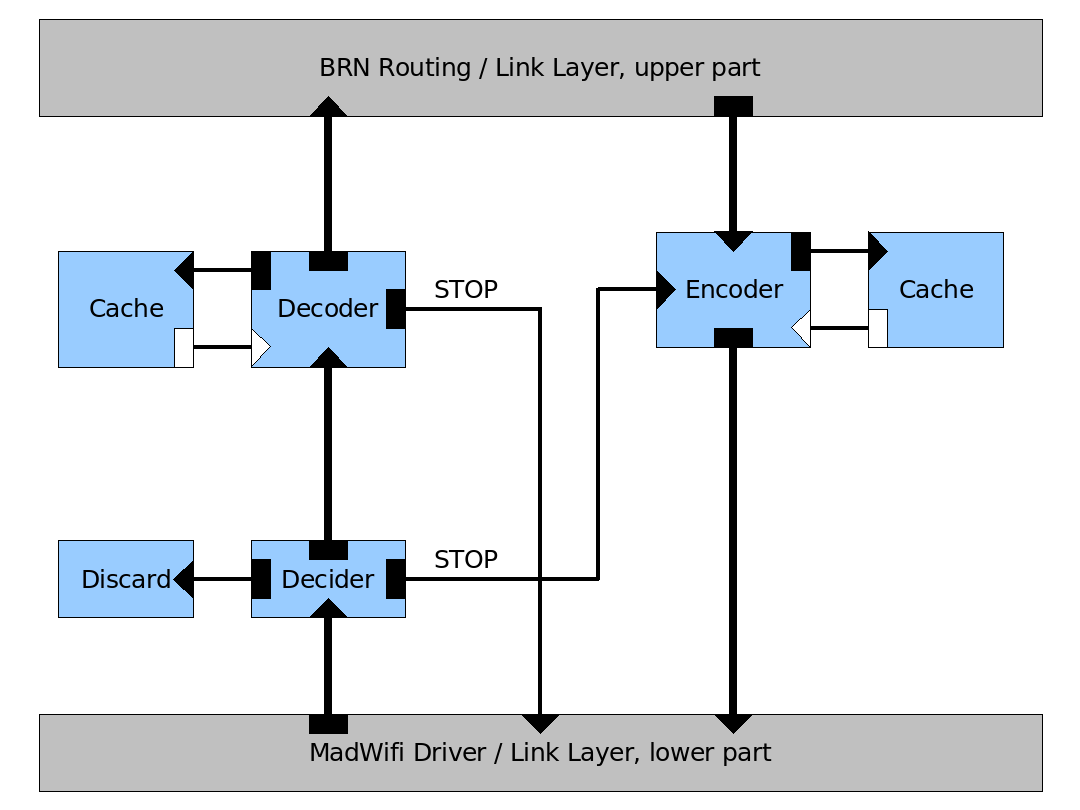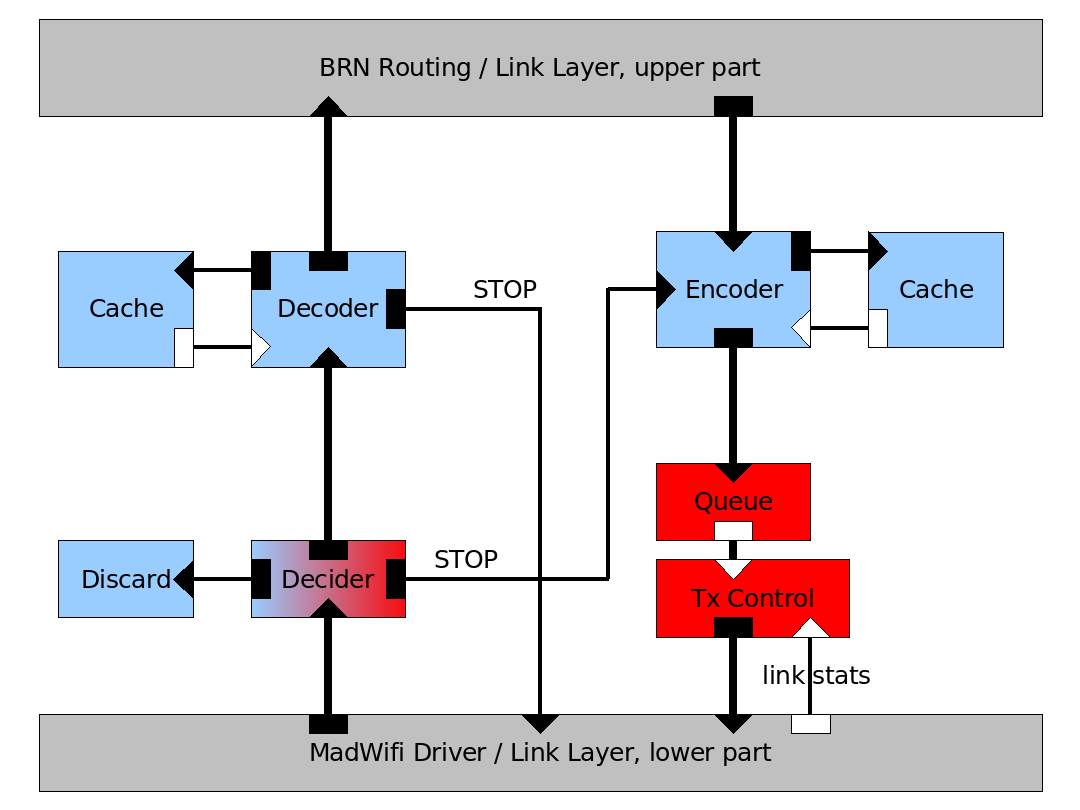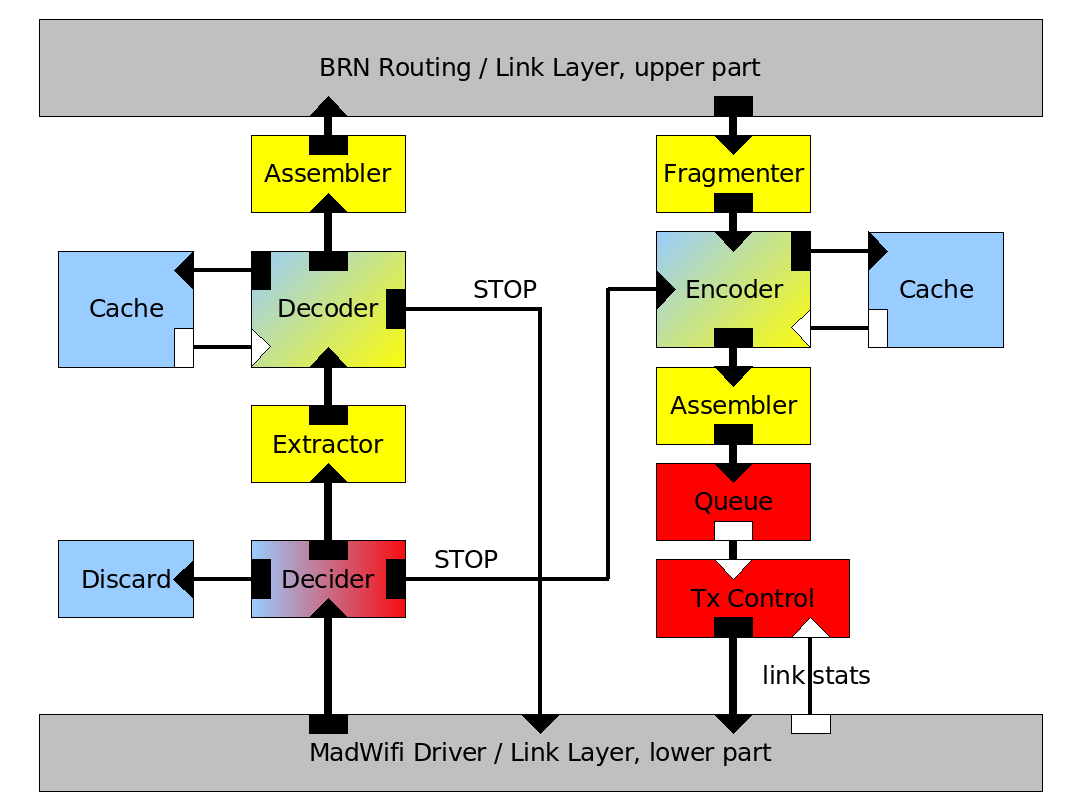BRN-070312-1: Difference between revisions
| Line 57: | Line 57: | ||
=== Architecture === |
=== Architecture === |
||
[[Image:NCarch1.png|right| |
[[Image:NCarch1.png|right|400px|part 1]] |
||
The architecture is built around existing components of the BRN infrastructure. Especially the MadWifi driver and the DSR routing algorithm are used. All algorithms are implemented using the Click modular routing toolkit. As DSR is also implemented using Click network coding can easily be inserted between the lower part of the link layer, provided by MadWifi and the upper part of the link layer, provided by DSR. Yet not all input and output of DSR is intercepted, only the frames coming from and going into the BRN network are used. The structure of the network coding algorithm can be described in three functionally independent units. |
The architecture is built around existing components of the BRN infrastructure. Especially the MadWifi driver and the DSR routing algorithm are used. All algorithms are implemented using the Click modular routing toolkit. As DSR is also implemented using Click network coding can easily be inserted between the lower part of the link layer, provided by MadWifi and the upper part of the link layer, provided by DSR. Yet not all input and output of DSR is intercepted, only the frames coming from and going into the BRN network are used. The structure of the network coding algorithm can be described in three functionally independent units. |
||
[[Image:NCarch2.png|right| |
[[Image:NCarch2.png|right|400px|part 2]] |
||
The first part is mainly concerned with encoding and decoding linear combinations of ethernet frames. This requires two caches for frames that couldn't be decoded yet or are still needed for encoding. In order to avoid link layer ACK messages all encoded frames are sent in broadcast mode. This means that another element, the decider, is needed to discard frames for which the current node is not among the intended recipients. The recipients can be determined using the source route information included in each frame. After successfully decoding a batch of frames the decoder emits a STOP message which is sent reliably with link layer ACK. On the receiving side this stop message is recognized by the decider and used to signal the encoder to stop sending packets of that batch. |
The first part is mainly concerned with encoding and decoding linear combinations of ethernet frames. This requires two caches for frames that couldn't be decoded yet or are still needed for encoding. In order to avoid link layer ACK messages all encoded frames are sent in broadcast mode. This means that another element, the decider, is needed to discard frames for which the current node is not among the intended recipients. The recipients can be determined using the source route information included in each frame. After successfully decoding a batch of frames the decoder emits a STOP message which is sent reliably with link layer ACK. On the receiving side this stop message is recognized by the decider and used to signal the encoder to stop sending packets of that batch. |
||
[[Image:NCarch3.png|right| |
[[Image:NCarch3.png|right|400px|part 3]] |
||
The second part adds the capability for opportunistic routing. The decider is extended so that it frames originally intended for nodes upstream in the source route are utilized. This means that multiple nodes can be able to decode a given batch simultaneously and start resending it. This is to be prevented by STOP messages. In order to further prevent excessive congestion and guarantee the delivery of STOP messages a transmission control module is inserted. Based on link statistics obtained from the low level driver and routing information the sending frequency is determined and controlled. For example a node knowing that its successor on the source route can overhear most frames directly from its predecessor will send less packets than a node constituting a bottleneck. Most likely modifications or additions to the lower layer will be needed to obtain these details. Also it might be useful to employ the STOP messages here in order to find out which nodes overheard how much of a given batch, before it was sent by a given node. |
The second part adds the capability for opportunistic routing. The decider is extended so that it frames originally intended for nodes upstream in the source route are utilized. This means that multiple nodes can be able to decode a given batch simultaneously and start resending it. This is to be prevented by STOP messages. In order to further prevent excessive congestion and guarantee the delivery of STOP messages a transmission control module is inserted. Based on link statistics obtained from the low level driver and routing information the sending frequency is determined and controlled. For example a node knowing that its successor on the source route can overhear most frames directly from its predecessor will send less packets than a node constituting a bottleneck. Most likely modifications or additions to the lower layer will be needed to obtain these details. Also it might be useful to employ the STOP messages here in order to find out which nodes overheard how much of a given batch, before it was sent by a given node. |
||
Revision as of 15:14, 21 April 2007
Network Coding for Bit-Error Recovery
Abstract
Die drahtlose Übertragung ist auf der physikalischem Ebene erheblich fehleranfälliger im Vergleich zu kabelgebundener Kommunikation. Im Standard IEEE 802.11 sind daher Vorwärtsfehlerkorrektur (FEC) und Automatische Wiederholungsanfragen (ARQ) vorgesehen, um Übertragungsfehler auf ein für höhere Protokollschichten zumutbares Maß zu begrenzen. Beide Techniken sind effektiv, wenn auch nicht optimal, bei der Unicast-Übertragung. Allerdings genügen sie nicht den Anforderungen von neuen Routing-Ansätzen wie Opportunistischem Routing, da das Anycast Link Layer Primitiv nicht abgebildet wird.
Ziel der Diplomarbeit soll es sein, für das Anycast Primitiv ein ARQ Schema mit inkrementeller Redundanz zu entwerfen. Mit einem funktionsfähigen Prototyp für Simulator und BerlinRoofNet Testumgebung soll die Leistungsfähigkeit des Ansatzes beurteilt werden. Da durch die Beschränkung auf COTS IEEE 802.11 Hardware die Datenübertragungs- und Sicherungsschicht unveränderlich ist, muss in der Realisierung entsprechend auf höhere Schichten ausgewichen werden.
Im Rahmen der Arbeit werden folgende Punkte näher betrachtet:
- Fehlererkennung innerhalb von Paketen auf Basis von Fragmenten; Weiterverarbeitung von korrekten Fragmenten innerhalb fehlerhafter Pakete.
- Verarbeitung von Batches als logische Zusammenfassung von Paketen; darin eingeschlossen die zuverlässige Signalisierung des vollständigen Batch-Empfangs am Empfänger.
- Random Linear Network Coding auf Basis von Fragmenten innerhalb eines Batchs zur Minimierung der übertragenen Redundanz.
- Integration einer Variante des opportunistischen Routings entlang der DSR Source Route.
- Verfahren zur Bestimmung der Senderate für netzwerk-kodierte Anycast-Pakete.
- Modellierung von Übertragungsfehlern auf Datenübertragungs- und Sicherungsschicht im Simulator (JiST/SWANS).
- Auswertung der erzielten Systemleistung im Simulator und in der BerlinRoofNet Testumgebung.
Contribution and Related Work
Related Work
- Link Level & Bit Error Measurements
- MIT Link Level Measurements
- Henri Dubois-Ferrière, Deborah Estrin, Martin Vetterli (EPFL) “Packet Combining in Sensor Networks”
- TU Berlin measurements
- Source and Network Coding
- Reina Riemann, Keith Winstein (MIT) “Improving 802.11 Range with Forward Error Correction”
- Digital Fountains and Linear Random Network Codes
- Szymon Chachulski, Michael Jennings, Sachin Katti, Dina Katabi (MIT) “MORE: A Network Coding Approach to Opportunistic Routing”
- Szymon Chachulski, Michael Jennings, Sachin Katti, Dina Katabi (MIT) "Trading Structure for Randomness in Wireless Opportunistic Routing"
- Sachin Katti, Hariharan Rahul, Wenjun Hu, Dina Katabi, Muriel Médard, Jon Crowcroft "XORs in The Air: Practical Wireless Network Coding"
- Hybrid ARQ, Packet Combining
- Allen Miu, Hari Balakrishnan, Can Emre Koksal (EPFL) “Packet Combining in Sensor Networks”
- Kyle Jamieson, Hari Balakrishnan (MIT) "PPR: Partial Packet Recovery for Wireless Networks"
- Henri Dubois-Ferrière, Deborah Estrin, Martin Vetterli (MIT) “Improving Loss Resilience with Multi-Radio Diversity in Wireless Networks”
- Opportunistic Routing
- MIT Biswas
- Candidate selection and routing metrics: Zhong
Contribution
The combination of partial packet recovery and network coding is expected to unite the benefits from both approaches. Partial packet recovery still creates overhead by sending ACKs for single packets and a system like MORE still drops a lot of packets which could be partially retrieved by splitting them into fragments.
Analysis and Design
Requirements
Constrains
- IEEE 802.11 MAC and PHY
- Preserve ISO/OSI layer separation
Out of Scope
Architecture
The architecture is built around existing components of the BRN infrastructure. Especially the MadWifi driver and the DSR routing algorithm are used. All algorithms are implemented using the Click modular routing toolkit. As DSR is also implemented using Click network coding can easily be inserted between the lower part of the link layer, provided by MadWifi and the upper part of the link layer, provided by DSR. Yet not all input and output of DSR is intercepted, only the frames coming from and going into the BRN network are used. The structure of the network coding algorithm can be described in three functionally independent units.
The first part is mainly concerned with encoding and decoding linear combinations of ethernet frames. This requires two caches for frames that couldn't be decoded yet or are still needed for encoding. In order to avoid link layer ACK messages all encoded frames are sent in broadcast mode. This means that another element, the decider, is needed to discard frames for which the current node is not among the intended recipients. The recipients can be determined using the source route information included in each frame. After successfully decoding a batch of frames the decoder emits a STOP message which is sent reliably with link layer ACK. On the receiving side this stop message is recognized by the decider and used to signal the encoder to stop sending packets of that batch.
The second part adds the capability for opportunistic routing. The decider is extended so that it frames originally intended for nodes upstream in the source route are utilized. This means that multiple nodes can be able to decode a given batch simultaneously and start resending it. This is to be prevented by STOP messages. In order to further prevent excessive congestion and guarantee the delivery of STOP messages a transmission control module is inserted. Based on link statistics obtained from the low level driver and routing information the sending frequency is determined and controlled. For example a node knowing that its successor on the source route can overhear most frames directly from its predecessor will send less packets than a node constituting a bottleneck. Most likely modifications or additions to the lower layer will be needed to obtain these details. Also it might be useful to employ the STOP messages here in order to find out which nodes overheard how much of a given batch, before it was sent by a given node.
The third part, finally, adds the capability to deal with fragments instead of whole ethernet frames. An extractor module retrieves the fragments from ethernet frames before having them decoded by the decoder. An assembler reassembles the original frames from a set of decoded fragments or combines a set of encoded fragments into a new frame. The fragmenter splits up the original frames into fragments that need to be encoded. The decoder and encoder have to be slightly modified so that they can handle fragments instead of frames but their principal functionality remains the same. Also the MadWifi driver needs to be configured to hand out corrupt frames to the upper layers.
Project Plan: Tasks
Milestones
Task 1: Hop-by-Hop NC scheme
- Similar to MORE
- Continuously send randomly (linear) coded packets from a defined batch to the next hop
- Don't send link layer ACKs for any packets
- Stop when next hop has enough correctly transmitted encoded packets to decode all originals.
- A node receiving encoded packets sends a special „STOP“ packet when all packets of a batch could be decoded.
- STOP should be sent reliably – in contrast to data packets. Find a way to accomplish that
- Try to reduce overhead and interference between multiple transmissions (Consider the Tx control from „XORs in the Air“)
Deliverable
- Realization for Simulation and on Netgear Hardware
Deadline: xx.xx.xxxx
Progress: 0% finished
Task 2: Extend NC to opportunistic routing
- Make use of „overheard“ packets
- Any downstream node can receive packets from a batch and send STOP if enough information is present
- Any STOP for a given batch prevents upstream recipients of that batch from resending its packets
- Find a route selection algorithm (consider for example MORE's Tx triggers)
Deliverable
- Realization for Simulation and on Netgear Hardware
- Performance Evaluation (report)
Deadline: xx.xx.xxxx
Progress: 0% finished
Task 3: Fragment Coding
- Instead of complete packets parts (fragments) are encoded
- Each fragment gets a seperate CRC
- Next node makes use of corrupted packets and extracts the fragments that have been correctly received
Deliverable
- Realization for Simulation and on Netgear Hardware
Deadline: xx.xx.xxxx
Progress: 0% finished
Task 4: Performance Evaluation and Optimization
- Sending packets in batches creates a considerable delay and burstiness at the receiver
- Compare that delay with standard WiFi communication
- Which applications can deal with that and which can't?
- Which parameters have an influence on the delay?
- How does the delay change with
- multi-hop coding
- resending of partially decoded batches
- different forms of Tx control
- sliding window coding
- Larger fragments mean less error recovery because larger parts of the packets have to be discarded
- Smaller fragments mean more overhead for the calculation of CRC and the meta-information in packets
- Evaluate different fragment sizes and find good values for various environments
- What other parameters have an influence on coding efficiency, overhead, delay or throughput?
- Based on these findings estimate the parameters for the coding algorithm at runtime
Deliverable
- Performance Evaluation (report)
Deadline: xx.xx.xxxx
Progress: 0% finished
Task 5: Extensions
- multi-hop coding, where packets are resent without decoding them (for simple and opportunistic routing)
- allow the next node to encode parts of the batch and resend them before all packets have been decoded
- regular status reports (for example after x data packets) announcing if a batch could be partially decoded
- generate realistical patterns of packet corruption in a simulation
Deliverable
- Implementation in the context of Tasks 1-3
- Performance Evaluation and Comparison
Deadline: none, optional task to be done if time is left
Progress: 0% finished


